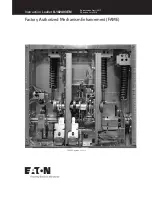
4 | Technical data
32/174
8DJH • Installation and Operating Instructions • Version 11 • 500-8384.9
Tab. 25:
Power consumption of circuit-breaker motor operating mechanism
Circuit-breaker
Max. power consumption
DC
AC
Type 2
approx. 80 W
approx. 80 VA
Type 1.1
approx. 170 W
approx. 230 VA
Tab. 26:
Rated current for the motor operating mechanism protection equipment
Rated supply voltage
1)
Recommended rated current for the protection equipment
2)
Circuit-breaker type 1.1
Circuit-breaker type 2
DC
24 V
8 A
3)
8 A
48 V
4 A
6 A
60 V
4 A
4 A
110 V
2 A
2 A
220 V
1.6 A
1.6 A
AC
110 V (50/60 Hz)
3 A
2 A
230 V (50/60 Hz)
2 A
1.6 A
1)
The supply voltage may deviate from the rated supply voltage by max. -20 % to +10 %.
2)
M.c.b. with C-characteristic
3)
Double bus wire
Breaking capacity
Operating voltage [V]
Normal current [A]
AC 40 Hz to 60 Hz
up to 230
10
Resistive load
Inductive load
DC
24
10
10
48
10
9
60
9
7
110
5
4
220
2.5
2
Closing solenoid (‑Y9)
The closing solenoid closes the circuit-breaker electrically. The closing command is executed by
application of an auxiliary voltage (AC or DC, depending on the design option).
After closing, the closing solenoid is de-energized internally.
Releases
Releases trip the circuit-breaker. The electrical opening command is transmitted to the OPEN
latch via a magnet armature by unlatching an energy store. Depending on the operating
mechanism used, up to 2 releases can be used.
▪
Shunt release (‑Y1)
Shunt releases are used to trip or electrically open circuit-breakers. The opening command is
executed by application of an auxiliary voltage (AC or DC, depending on the design option).
After opening the circuit-breaker, the release is de-energized internally.
▪
Shunt release (‑Y2)
The shunt release (-Y2) can be operated as an additional release besides the shunt release (-
Y1), and works in the same way.
▪
Undervoltage release (‑Y7)
Undervoltage releases are used to trip or electrically open circuit-breakers. During normal
operation, the shunt releases are supplied with a closed-circuit current from an auxiliary
voltage source (AC or DC, depending on the design option). When the auxiliary voltage falls
below a specific value, or when it is interrupted, the opening operation takes place.
▪
C.t.-operated release (‑Y4)
The c.t.-operated release
3AX1102
is used for protection devices with a relay output, which
are supplied with c.t. current. The tripping circuit is supplied via auxiliary instrument
transformers for tripping. When the required tripping current (0.5 A or 1 A, depending on
the design option) flows in the tripping circuit, the opening operation takes place.
Summary of Contents for 8DJH
Page 173: ......






































